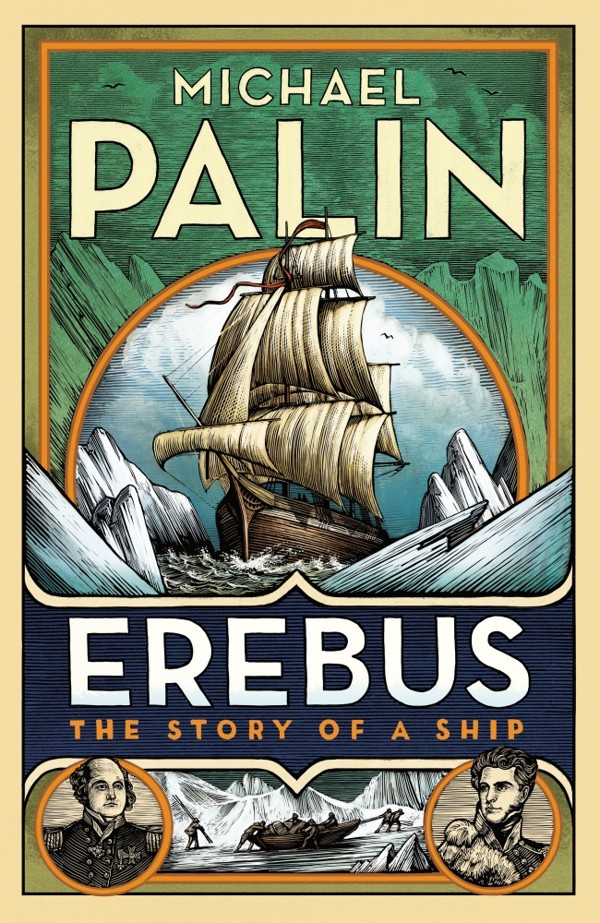
Review | Michael Palin retraces final journey of ill-fated HMS Erebus in new book, tries to piece together ship’s tragic end
The beloved broadcaster and actor brings the 19th-century Royal Navy ship and its crew to life as he relives the perilous expeditions it undertook, even if routine naval life did not always prove exciting
Erebus: The Story of a Ship
By Michael Palin
Hutchinson
Broadcaster and actor Michael Palin’s televisual adventures have taken him around the world, from pole to pole, through Brazil and “new Europe”, across the Sahara and Himalayas, and along the great railway lines of Britain. He was once president of the Royal Geographical Society and, a member of surreal comedy group Monty Python, Palin has always injected his accounts with gentle irony and wit.

Sailing in the first half of the 19th century, during the reign of Queen Victoria and when British hegemony was unchallenged, the frontiers that the Royal Navy’s HMS Erebus crossed were scientific rather than military. The mission of its early voyages was to gain knowledge of the global position – through magnetic data – of various landmasses. (This, Palin says, would enable the Victorian navigational equivalent of a global positioning system.)
Subsidiary pursuits included naturalist exploration and the cataloguing and bringing back to Britain of various specimens, and Palin conveys wide-eyed wonder at such discoveries. But, at a time when neither pole had been reached, the expeditions are where the true adventure lies, and the Erebus travelled further south than any ship had before.
Leaving London in 1839, the vessel made its way to Simon’s Town, in South Africa, and then, in 1840, to Hobart, in Tasmania (then called Van Diemen’s Land). An extensive Antarctic tour followed in 1841, before a stop in New Zealand, and then another Antarctic exploration along a similar route in 1842. The ship made its way to the Falkland Islands and the Tierra del Fuego archipelago before (the crew’s teeth rather gritted) one final polar expedition to the northernmost point of the Antarctic Peninsula and further southeast, eventually returning home via Rio de Janeiro, Brazil.
Palin’s recreation of the Erebus’ voyages and crews is vivid, with sources including letters and journals written by officers and sailors, as well as official documents [...] but there is a sense, writes Palin, of tensions among the crew going unmentioned
In 1845 (by which time the ship had been fitted with a 25-horsepower steam engine), and under the captaincy of Sir John Franklin, the former governor of Van Diemen’s Land, the Erebus set off in an attempt to locate the Northwest Passage through the Canadian Arctic Archipelago, where, amid icebergs and frozen seas, she was lost (the sunken wreck would not be discovered until September 2014).
This bald summary gives no sense of the expedition’s travails, the most extreme danger coming early in 1842, deep in Antarctic waters, when the Erebus and sister ship HMS Terror were among icebergs (“At one time, we counted ninety,” second master John Davis noted) and the cold was intense. With an iceberg bearing down on them, a collision became inevitable: either the Erebus would hit Terror or the iceberg. The two ships slammed together and “Erebus’s bowsprit ‘snapped to atoms’, her foretopmast and all the booms, stays and rigging were torn away”. Captain Francis Crozier was forced to steer the Terror through “a frightening narrow gap in the wall of ice” but, somehow, both ships survived, making it to Cape Horn, in Tierra del Fuego, and then the Falklands for repairs.
Palin’s recreation of the Erebus’ voyages and crews is vivid, with sources including letters and journals written by officers and sailors, as well as official documents. The records’ integrity is in no doubt but there is a sense, writes Palin, of tensions among the crew going unmentioned.

Letters to wives and family appear self-censored, possibly so as not to alarm the recipients, or perhaps Victorian men were remarkably hardy, because the records reveal little of the stresses of life in uncomfortable quarters (the men were packed in, sleeping in hammocks), with long periods of boredom. The daily grog ration – a quarter of a pint per man – may have helped.
Palin’s superb excavation of records and dutiful following of the Erebus’ passage result in two unavoidable flaws. Firstly, for the most part, lengthy sea voyages are dull. Palin interjects what interest he can – with his own reminisces of approaching Antarctica, landing in the Falklands and his stay in Tasmania – and takes pleasure in uncovering little-known facts: the wood for the Erebus came from the Forest of Dean, in Gloucestershire, and was transported by barge down the River Severn; the shipbuilder sent the Royal Navy a bill for £14,603 (equivalent to about £1.3 million [HK$13 million] in today’s money).
One of the loveliest scenes he evokes is the celebration of New Year’s Day 1842, Erebus trapped in the ice, with dancing (reels and the quadrille), flags, bells, gongs, snowball fights and ice cream.
But such delights are few and far between: for the most part, the ship slowly makes its way as the routines of naval life (scrubbing decks, hoisting sails, ensuring discipline) are maintained. Consequently, the narrative can feel laboured. Palin records, for instance, every bird killed by the ship’s surgeon and naturalist Robert McCormick during his ventures onto land and ice.
Basil Pao’s photo exhibition brings Michael Palin’s travels alive
The second flaw is that Palin cannot provide a narrative for the loss of the Erebus and the death of its 68 men. There are, of course, no first-hand accounts and the author sticks to what can be verified, telling of rescue expeditions and the agonisingly slow return of slivers of information. What might, in a novel, have been a key moment, with drama and terror and courage, is instead a void.
Palin ponders possible fates by examining “other ships in similar situations” and, with growing horror, we discover that following the ship’s sinking, the remaining men might have resorted to “the last dread alternative, as a means of sustaining life” – cannibalism.
Erebus is a considerable scholarly and storytelling achievement. Palin’s historical evocation is meticulous, as is his sense of geography, and his narrative is well-paced, despite occasional longueurs. He brings the Erebus, and its men, to life, adeptly capturing their bravery and achievements, and the context in which they sailed.

